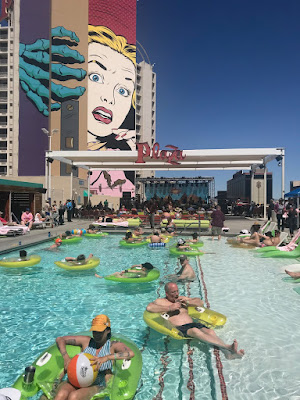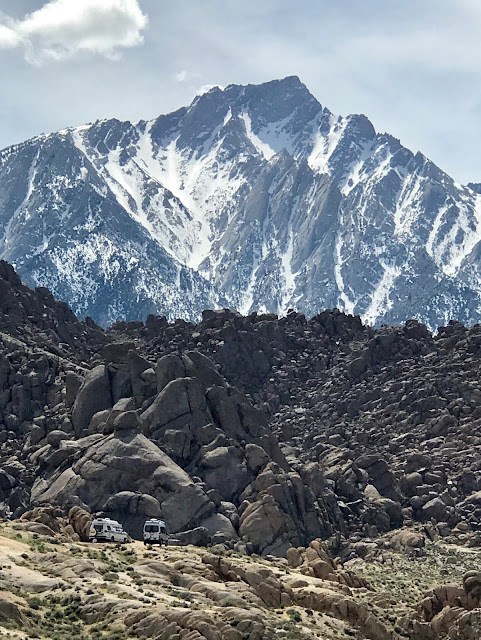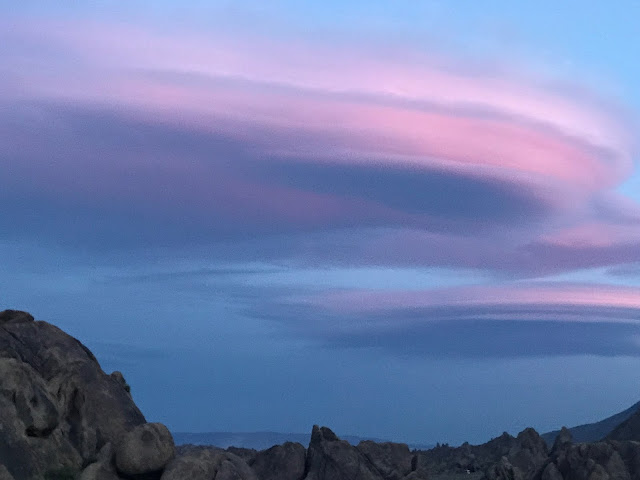When our son Chris and his partner Chelsea urged his restless parents to join them for winter camping and hiking on the Olympic Peninsula (OP), we practically shouted YES!, even though we'd be traveling north—into the rain.
This has been the first winter in a half dozen that PK and I haven't fled Oregon's dismal damp by traveling south—into the sun. In recent years, we've been terribly spoiled exploring the American southwest and the Baja Peninsula in our van and then fulfilling lifelong dreams of exotic foreign travel adventures in both hemispheres.
Naturally, we've been peevish during the damn pandemic. A few quick get-aways did not remedy our high standing on the restlessness scale.
 |
| Our guides enjoying a sweet sunrise at Lake Ozette. |
Chris and Chelsea live, temporarily, in their Airstream "home" close to Port Angeles, a small city on the edge of the Olympic rainshadow, where the average annual rainfall is just 26 inches. We enjoyed relatively benevolent weather as our enthusiastic guides showed off their new territory.
 |
| We saw this as we followed Chris and Chelsea in their Nevervan at the start of our tour. The weather improved in about a half-hour. |
 |
Happy campers! The black trailer is a workspace and storage unit.
The Airstream is home-sweet-home. |
Like everybody else, Chris' and Chelsea's lives were upended by the pandemic. This time of year, Chris would have been on, or planning, a kayaking expedition. Chelsea would be doubling down on her Ph.D. dissertation and preparing for another season as a cruise ship naturalist for Lindblad Expeditions-National Geographic Instead, they migrated in the fall of 2020 to the OP from Washington's North Cascades before winter storms could hold captive the Airstream trailer they call home.
Ramblers that they are, their intent was to stay for the winter and migrate elsewhere come spring. But it didn't take long before the OP cast a spell that has them discussing becoming first-time property owners. Their intention—and hope—is to settle near Port Angeles, the closest town to where they're now temporarily camped. |
Falling in love with the Olympic Peninsula (OP) is easy to understand. The 96-mile Strait of Juan de Fuca provides ocean perks and a gorgeous north-facing coastal strip where a handful of communities have developed. On the south side of the coastal strip lies a great wilderness area—the Olympic National Park.
From the park's website:
Encompassing nearly a million acres, the park protects a vast wilderness, thousands of years of human history, and several distinctly different ecosystems, including glacier-capped mountains, old-growth temperate rain forests, and over 70 miles of wild coastline.
And kayaker Chris would add at least 19 wild rivers. With an abundance of mountains, rivers, lakes, and ocean beaches, outdoor adventures are practically unlimited. The national park alone has at least 52 trails comprising 611 trail miles. We barely scratched the surface.
If only we were younger....nevermind.
Chris and Chelsea showed off some of their favorite places so far. Although they've only lived on the OP since October 2020, their explorations have been continuous. If you choose to visit the OP, you could do worse than follow their lead.
SALT CREEK RECREATION AREA AND CRESCENT BAY - DO NOT MISS
 |
| A sweet sight from a coastal trail in the Salt Creek Area. |

Atop the aerial photo, Crescent Bay has a private beach and is a separate entity from the official Salt Creek Recreation Area and Campground. The campsites visible accommodate large RVs requiring hook-ups. However, the wooded area between the RV camp and the bay includes some of the most desirable campsites PK and I have ever seen.
The Salt Creek Area offers stunning views from trails along the bluffs and from at least half of its campsites, many of which are fenced to prevent campers from stumbling to the ocean and rocks below. Numerous side trails and stairsteps provide access to coves, fishing rocks, and tidepools. We shared a perfect campsite with Chris and Chelsea in our respective Sprinter vans. |
 |
| A cove accessed by a steep path from a 5-mile RT trail is within the Salt Creek Recreation Area. |
The area also includes the Tongue Point Marine Life Sanctuary protecting prolific tidepool creatures. (If you have time, open the link. Impressive photos!) Sadly, the tide wasn't low enough for us to navigate the pools. Another Salt Creek area highlight is significant historic World War II bunkers with interpretive signs.
 |
| Hiking buddies posing on a lush trail. |
CRESCENT BAY
Crescent Bay, adjacent to Salt Creek, is popular with - are you ready - surfers! One of whom is Chelsea, an avid type who took to the board growing up in southern California. The day we visited, maybe a dozen surfers were catching February waves, some of them likely camping at the private campground on Crescent Bay.
 |
| Chelsea's photo of a perfect winter surfing day on Crescent Bay. |
Unlike Oregon's public coastline, many Washington beaches, including the one at Crescent Bay, are private property. A parking lot off Highway 112 provides bay access for surfers and those who want to explore the adjacent rocky shore and world-class tidepools of the neighboring Salt Creek Area.
 |
| Chris is paddling out to join Chelsea, who's surfing and too far away to photograph. This spot is 15 minutes from their Airstream base. |
 |
| On another day, Chris caught Chelsea exulting on Crescent Bay. |
OZETTE LAKE, DINNER IN THE RAIN, AND A BOARDWALK HIKE TO THE SEA
Ozette Lake, part of the Olympic National Park, is about a 3- hour drive from Port Angeles. We'd planned to settle into the lake's campground late in the afternoon, but problems came up: the campground was closed by flooding, rain was still falling, and darkness was closing in.
 |
It didn't take long to determine that the campground was out.
|
 |
But a gravel parking lot worked fine. Festive lights brightened our spirits, as did communal camp cooking.
|
 |
Good Morning Sunshine!
|
 |
That morning we set off on a 6.3-mile roundtrip cedar-boardwalk path to the Cape Alava beach. The trail cut through a dense forest of typically lush but aggressive OP vegetation. We were awed by the work required to prevent the dense flora from eating the trail. |
Hikers have options: a round-trip to the beach and back in 6.3 miles, or a 9.4-mile triangular route beginning with the boardwalk trail we hiked, then a left turn along the beach past petroglyphs, then another left onto a trail that intersects the boardwalk near the trailhead.
 |
| We arrived at Cape Alava in time for lunch and leisurely enjoyment. Had we decided on the 9.4-mile option, we would have been rushing. I'd love to see the petroglyphs and the alternate trail back. Maybe next time. |
 |
As it was, we had time to obverse dozens of bald eagles and enjoy the
solitude, sounds, and scents of a pristine wilderness beach.
Then on to the next great place, Rialto Beach
|
RIALTO BEACH
I've seen a lot of ocean beaches, but Rialto takes the cake for drama. Colossal Pacific Ocean waves crash onto a steep beach, which is stacked high with huge logs, more logs than we've seen on any beach anywhere.
Chelsea and Chris had visited Rialto Beach a few weeks earlier at high tide when behemoth winter waves broke onto the logs, causing them to float and crash with enormous power and racket. I wish we could have witnessed that show, but what we observed was also awe-inspiring.
However, if you're looking for accessibility, Rialto is not good; one must first navigate the logs to walk along the beach.
 |
| Chris shot this photo of Chelsea on an earlier trip. |
 |
| PK and I on Rialto Beach in our not-meant-to-be-matching jackets and fleece-lined trousers. Chilly! The surf had calmed since the previous day. |
 |
| Seastacks framed by a beached log |
 |
| The rocky beach looks bland, but colorful rocks hide there. |
We hung out atop a beach log and enjoyed smoked salmon, crackers, and cheese and shared a bit of wine as we watched the sky darken - not really a sunset. When we arrived at the Mora Campground just a few miles up the road, it was dark— early February kind of conditions. A light but persistent rain set in, and we made quick work of finishing a simple dinner.
BOGACHIEL RAINFOREST TRAIL
Light rain continued the next morning, our last day on the OP. We discussed our options: get an early start home along Highway 101, which veers away from the ocean for much of the way to the Oregon border. Or hike in the rain with Chris and Chelsea on one of the national park's rainforest trails. And then start the drive south.
Hmmm. Not much of a decision. Of course, we did the hike.
The trail follows the Bogachiel River, one of the 19 wild rivers Chris is documenting, source-to-sea, in his kayak. (More about his project below.)
 |
We walked for 90 minutes or so before taking a loop back to the start. The muddy trail continued along the river, likely crossing more streams with log bridges, some with handrails, some without—Chris photo credit.
|
 |
| Fungi flourishing in the rainforest. |
 |
Chartreuse is a dominant rainforest hue.
|
 |
| Time to say goodbye along the Bogachiel River, one of the 19 Chris is documenting in the name of conservation. Chelsea photo credit. |
MORE ABOUT CHRIS AND CHELSEA
Chris has been a professional kayaker since 2009 when Eddie Bauer offered his first sponsorship. He is also a professional photographer and a filmmaker, writer, and conservationist. His current project: Explore and document the OP's 19 wild rivers, source to sea, supporting current proposed Washington state legislation to protect them under the national Wild and Scenic Rivers Act. (As of this writing, the House of Representatives has passed the bill, which has moved on to the Senate.)
Facebook post
 |
One of the 19 OP rivers being proposed for protection under the
Wild and Scenic Rivers Act. |
If you'd like to "see more," follow Chris on Facebook or Instagram
------
 |
A brilliant student and
endlessly curious. |
Chelsea Behymer is a determined Oregon State University Ph.D. candidate working on her dissertation and looking forward to her new seasonal job in Port Angeles. She'll guide mountain biking, canoeing paddleboarding adventures. Chelsea was a cruise ship naturalist during vacations throughout her college career, most recently with Lindblad Expeditions-National Geographic. In this photo, she's searching for wild cranberries in a rainforest meadow near Ozette Lake.
EARLIER POSTS
Around the Horn 2018 with Chris and Chelsea - one of our best-ever adventures
Hoh Rainforest 2016 OP trip


























































